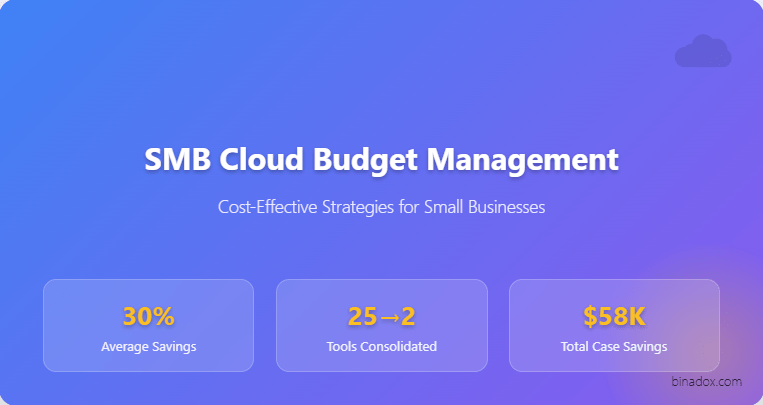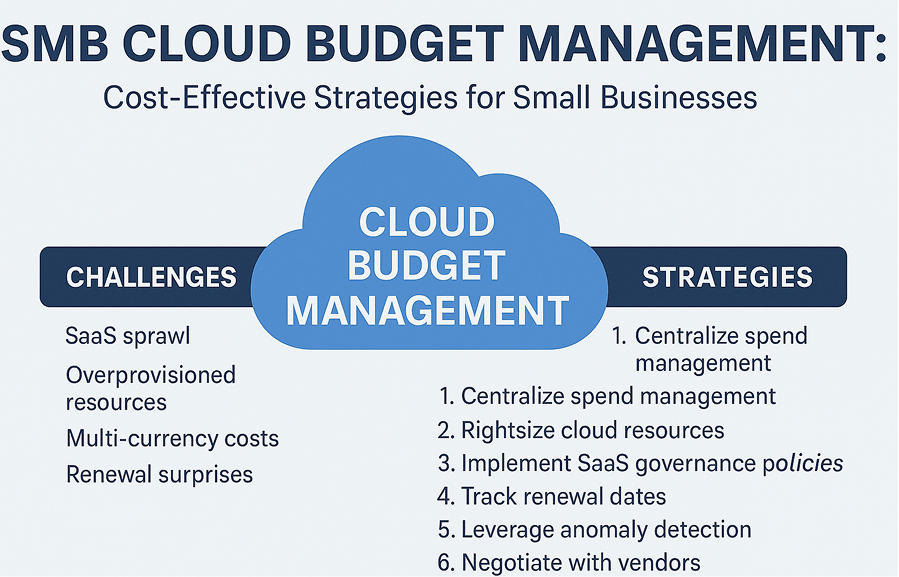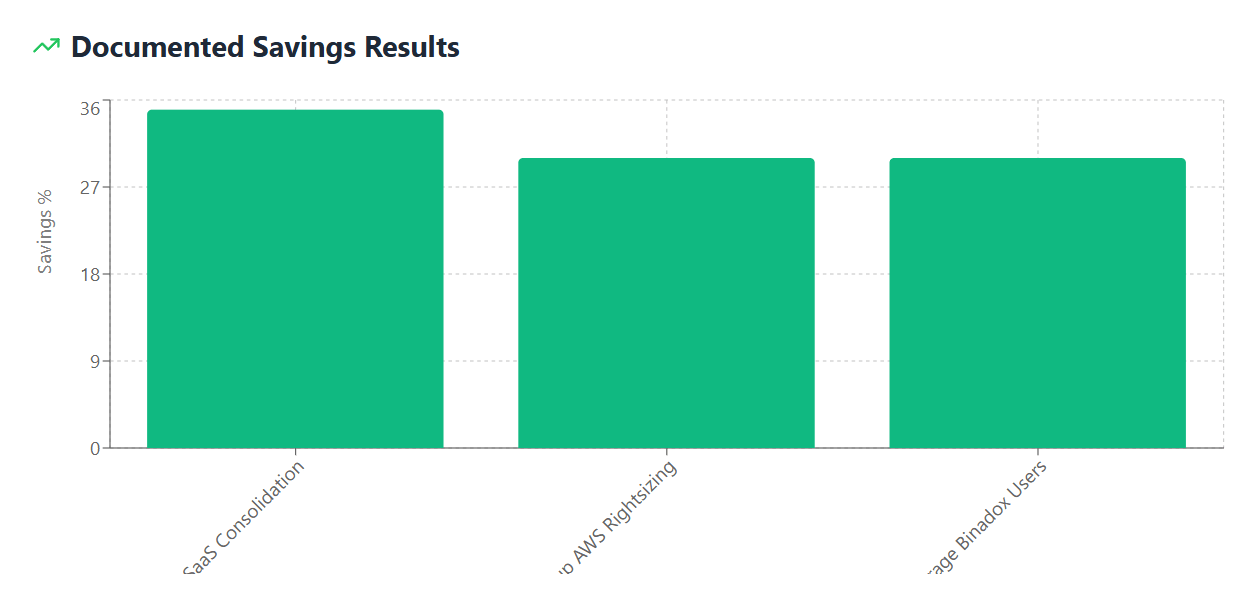
Introduction
Small and mid-sized businesses (SMBs) are increasingly turning to cloud and SaaS solutions to streamline operations, improve flexibility, and compete with larger enterprises. However, managing a cloud budget effectively remains one of the biggest challenges for SMBs. Unlike large enterprises with dedicated IT and financial teams, smaller companies often lack the resources and expertise to control costs across multiple SaaS apps and cloud providers.
In this article, we will explore cost-effective strategies for SMB cloud budget management, highlight common pitfalls, and discuss practical tools and frameworks that enable small businesses to optimize expenses without sacrificing innovation or growth.
Why Cloud Budget Management Matters for SMBs
The appeal of cloud computing lies in its scalability, accessibility, and predictable subscription-based pricing. SMBs can access enterprise-grade software and infrastructure without significant upfront investments. However, this flexibility also creates risks:
- Uncontrolled SaaS adoption across teams can lead to subscription sprawl.
- Underutilized cloud resources often drain budgets without delivering value.
- Currency fluctuations and multi-country operations complicate cost visibility.
- Hidden renewal dates for SaaS applications can surprise finance teams.
According to Gartner, SaaS and cloud services spending continues to grow annually, with SMBs driving much of this adoption due to digital transformation needs. Without strategic budget management, these investments can quickly turn into financial burdens.
Key Challenges SMBs Face in Cloud Cost Management
1. SaaS Sprawl and Lack of Visibility
SMBs often subscribe to multiple SaaS tools like Slack, Zoom, Salesforce, and project management platforms. Over time, these subscriptions accumulate—many overlapping in functionality. Without visibility into what’s being used, companies may pay for abandoned or redundant tools.
2. Overprovisioned Cloud Resources
Public cloud providers like AWS, Azure, and Google Cloud make it easy to spin up servers, storage, and virtual machines. But SMBs frequently fail to rightsize these resources, leaving idle or oversized instances running and inflating costs.
3. Multi-Currency and Multi-Region Complexities
SMBs expanding across countries face challenges in consolidating cloud invoices. Different currencies and tax rules can create confusion and misreporting.
4. Renewal Surprises
SaaS subscriptions often auto-renew. Without centralized tracking, SMBs miss renewal dates, paying for software they no longer use.
5. Limited Expertise
Many SMBs lack in-house cloud cost optimization experts. This often results in missed opportunities for rightsizing, automation, and negotiation.

Cost-Effective Strategies for SMB Cloud Budget Management
1. Centralize Cloud and SaaS Spend Management
The first step toward effective budget management is centralizing cost data. Rather than tracking invoices across multiple bank accounts, SMBs should use a SaaS management platform like Binadox that consolidates all expenses into one dashboard.
Key benefits of centralization:
- Clear visibility into all SaaS and cloud spend.
- Ability to segment costs by region, department, or team.
- Easier identification of unused or duplicate subscriptions.
2. Rightsize Cloud Resources
Rightsizing ensures that cloud workloads match actual usage. For example, an SMB running development workloads on high-performance servers may downsize to smaller instances without compromising performance.
Best practices:
- Use a Cloud Utilization Dashboard to track workloads.
- Apply automated rules that flag idle or oversized instances.
- Regularly review instance types and switch to cheaper reserved or spot instances when possible.
3. Implement SaaS Governance Policies
To avoid SaaS sprawl, SMBs should establish governance policies:
- Require procurement approval before adopting new SaaS tools.
- Enforce user access controls to prevent unnecessary license purchases.
- Conduct quarterly SaaS audits to identify unused subscriptions.
By centralizing procurement and setting approval workflows, SMBs can balance employee productivity with financial discipline.
4. Track Renewal Dates with a Calendar
One of the most common cost leaks for SMBs comes from forgotten renewals. Tools like the Binadox Renewals Calendar help finance and IT teams see all upcoming SaaS renewal dates in a single place.
This enables:
- Timely cancellations of unused licenses.
- Proactive negotiations with vendors before renewal.
- Avoidance of surprise charges.
5. Leverage Cost Explorer and Anomaly Detection
Budget management is not only about cutting costs but also about spotting anomalies. A Cost Explorer tool can identify spikes in spending, enabling quick corrective actions.
For SMBs, even small anomalies matter. For example:
- A misconfigured service running for days could double the monthly bill.
- Unexpected foreign exchange charges might inflate SaaS invoices.
Automated alerts prevent these surprises from becoming major issues.
6. Negotiate with SaaS Vendors
Many SMBs assume pricing is fixed, but SaaS vendors often provide discounts for bulk purchases or long-term commitments. Best practices include:
- Negotiating enterprise agreements even for small teams.
- Asking for flexible license options when scaling up or down.
- Consolidating multiple tools with one vendor to unlock volume discounts.
7. Automate Budget Rules
Automation ensures discipline without manual oversight. Platforms like Binadox let SMBs create automation rules to suspend or downgrade underutilized licenses.
For example:
- Deactivate a Zoom license if not used for 90 days.
- Automatically downgrade AWS instances if CPU usage stays below 20%.
8. Use Spend Segmentation with Tags
Cloud providers allow tagging resources by team, project, or region. SMBs can then allocate budgets more effectively. For example, tagging workloads as Marketing or Development helps measure ROI by department.
9. Embrace FinOps Principles
FinOps is a cultural practice where finance, operations, and engineering collaborate to manage cloud costs. For SMBs, adopting simplified FinOps practices can be transformative:
- Weekly standups to review cost anomalies.
- Shared dashboards between IT and finance.
- Clear ownership of SaaS tools across departments.
10. Choose Transparent Pricing Tools
Some third-party cost management platforms charge based on cloud spend volume, creating conflicts of interest. Tools like Binadox, however, offer transparent pricing models not tied to usage volume. This ensures SMBs don’t face increasing software costs as they optimize.

How Binadox Helps SMBs Control Cloud Budgets
Binadox provides an all-in-one cloud and SaaS spend management solution designed for companies of all sizes. For SMBs, its features directly address common pain points:
- SaaS Utilization Dashboard – Monitors license usage and highlights abandoned apps.
- License Manager – Centralizes SaaS invoices, payment history, and renewal tracking.
- Cloud Dashboard – Provides visibility into AWS, Azure, GCP, and other providers.
- Rightsizing and Cost Explorer – Suggests optimization opportunities for cloud workloads.
- Automation Rules – Automatically deactivates unused licenses or flags anomalies.
- Teams & Tags – Segments cloud and SaaS costs by department or region.
With these tools, SMBs typically achieve average savings of 30% on their cloud and SaaS budgets.

Real-World Examples of SMB Budget Optimization
Case 1: Marketing Agency Reduces SaaS Waste
A 50-person marketing agency discovered they were paying for 25 project management tools across teams. By consolidating into two platforms and cancelling unused licenses, they cut SaaS spend by 35%.
Case 2: Startup Rightsizes Cloud Workloads
A tech startup running development workloads on AWS was overspending on oversized EC2 instances. Using rightsizing recommendations, they downgraded 40% of servers, saving $8,000 annually.
Case 3: Consulting Firm Automates Renewals
A consulting firm used the Binadox Renewals Calendar to track SaaS subscriptions. They avoided $15,000 in surprise renewals by cancelling tools before auto-renewal.
Emerging Trends Impacting SMB Cloud Budgets
- AI-Driven Optimization – SaaS management platforms increasingly integrate AI/ML to predict usage and recommend cost-saving actions.
- Vertical-Specific SaaS Tools – SMBs adopt niche SaaS solutions tailored to industries like healthcare, finance, or retail.
- Edge Computing – For SMBs with IoT or real-time data needs, edge computing may reshape cost strategies.
- Global SaaS Procurement – Multi-region SMBs increasingly require tools that handle multi-currency reporting.
Best Practices Checklist for SMBs
- Centralize SaaS and cloud costs in one platform.
- Audit SaaS subscriptions quarterly.
- Rightsize cloud resources monthly.
- Negotiate with vendors before renewal dates.
- Implement SaaS governance and approval workflows.
- Use automation rules to enforce cost discipline.
- Share dashboards between finance and IT.
- Segment spend by team and project.
Conclusion
For SMBs, cloud and SaaS budget management is both a challenge and an opportunity. Left unchecked, subscription sprawl and idle cloud resources can strain limited budgets. But with the right cost-effective strategies—from centralizing spend management and rightsizing resources to leveraging tools like Binadox—small businesses can achieve significant savings while maintaining agility.
By adopting governance policies, negotiating proactively, and embracing automation, SMBs can transform cloud costs from a liability into a competitive advantage. In the digital-first economy, mastering cloud budget management is not optional—it’s essential for growth, resilience, and long-term success.

